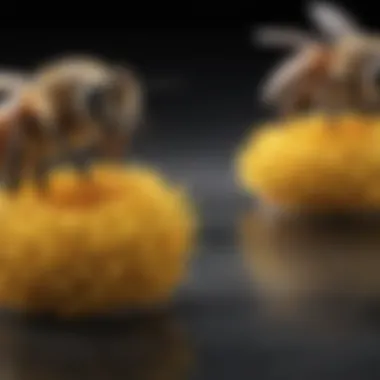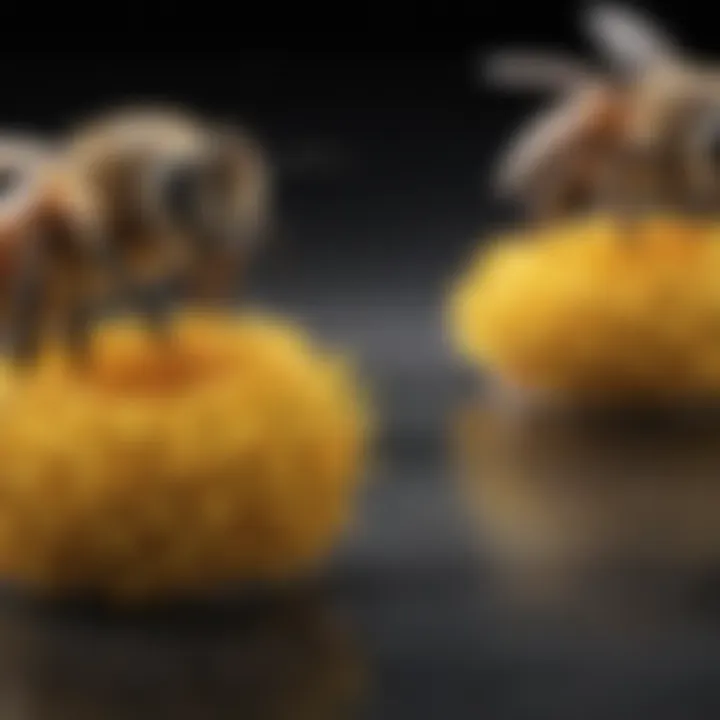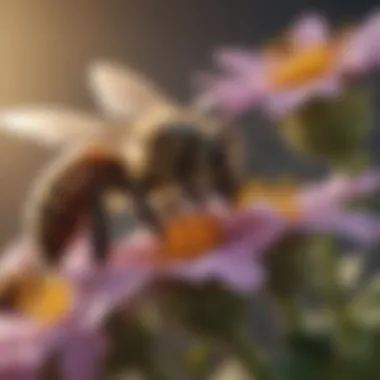Effective Bee Control: Natural and Non-Natural Methods


Intro
As individuals increasingly engage in gardening and outdoor activities, the presence of bees has become more prominent. While bees are essential for pollination and maintaining ecological balance, their activities can sometimes lead to conflicts with humans. Understanding how to manage bee populations is crucial for homeowners and gardening enthusiasts who seek to maintain a harmonious outdoor environment. This article will delve deeply into the various methods for bee control, focusing on effective strategies that consider both bee welfare and ecological balance.
Understanding the Pest
Identification
The first step in managing bee populations is accurate identification. There are various species of bees, including honeybees, bumblebees, and solitary bees. Each has unique characteristics and behaviors. Honeybees are social insects, forming large colonies, while bumblebees are larger and often live in smaller groups. Solitary bees, as the name suggests, do not form colonies and tend to nest alone. Knowing the species present on your property is crucial for deciding appropriate management strategies.
Life Cycle
Understanding the life cycle of bees aids in effective management. Most bees undergo four developmental stages: egg, larva, pupa, and adult. The cycle begins when a female bee lays eggs. After several days, these eggs hatch into larvae, which feed and grow until they're ready to pupate. Following this, they emerge as adults ready to fulfill their roles in the colony. This information is vital for timing any management practices, as certain methods may be more effective during specific stages of development.
Pest Prevention Strategies
Environment Modification
One of the most effective methods for preventing bee issues is modifying the environment. By eliminating potential nesting sites, such as old wood piles or abandoned structures, homeowners can deter bees from settling nearby. Moreover, keeping flowers deadheaded and reducing excessive flowering plants near building perimeters can limit the attraction of bees to residential areas.
Physical Barriers
Installing physical barriers is another proactive approach to manage bees. Screens on windows and doors can prevent bees from entering homes. Additionally, for outdoor spaces, constructing barriers or using netting around flower beds can keep bees at bay, while still allowing for pollination of other plants within a designated area.
Control Methods
Chemical Control
In some cases, chemical controls may be necessary. However, it is vital to choose options that are selective and targeted to avoid harming non-target species. Products such as permethrin can be effective against bees, but caution must be used in application, particularly during times when bees are active. One should always follow label instructions for the safest and most effective use.
Biological Control
Biological control methods involve using natural predators to manage bee populations. While this can be less common specifically for bees, encouraging birds or beneficial insects that prey on pest species can aid indirectly in managing the overall population in a balanced ecosystem. This approach often requires a long-term investment in fostering the right environmental conditions rather than immediate results.
Understanding and managing bees requires a careful balance between controlling their populations and preserving their role in the ecosystem.
By employing a combination of prevention and control strategies, homeowners can effectively manage bees on their properties while still promoting a healthy and diverse garden environment.
Prelims to Bee Management
Bee management is a crucial aspect of maintaining ecological balance and ensuring the health of our environment. It involves systematic methods to control bee populations while minimizing harm to these important pollinators. Understanding these methods is essential for various stakeholders, including homeowners, gardeners, and pest control professionals.
The significance of bees cannot be overstated. They play a vital role in pollination, which is essential for the growth of many plants and crops. Without effective bee management, overpopulation can lead to negative consequences, including aggressive behavior and ecological imbalance. Thus, having a comprehensive approach to bee management helps in creating a harmonious co-existence between humans and bees.
Moreover, this article aims to equip readers with various strategies that include preventive measures, natural deterrents, and chemical solutions. Familiarity with bee behavior is also necessary to inform choices regarding the best management methods. Therefore, understanding how to manage bee populations responsibly is not merely about controlling pests; it is about embracing sustainable practices that benefit all organisms within our ecosystem.
Importance of Bees in the Ecosystem
Bees are not just insects; they are integral to our ecosystem's health. They contribute significantly to the pollination of flowering plants, which in turn supports biodiversity. Around 75% of the crops that supply most of the world's food depend on bees and other pollinators. For instance, fruits like apples and vegetables like cucumbers would see reduced yields without bee activity.
The ecological services provided by bees extend beyond agriculture. They help maintain the genetic diversity of plants, which is important for ecosystem stability. Moreover, bees contribute to the food webs that support various animal species. Therefore, preserving bee populations goes hand in hand with maintaining the health of our environment.
In summary, the importance of bees cannot be overlooked; their role in pollination sustains both natural ecosystems and agricultural production.
Challenges of Bee Overpopulation
Despite the crucial role bees play, their overpopulation poses distinct challenges. When bee populations grow unchecked, they can become a nuisance or even a threat to human safety. For instance, increased bee activity can result in higher instances of stings, which may lead to allergic reactions for some individuals.
Furthermore, overpopulation can lead to competition for resources among bee colonies. This competition may harm the overall health of bee species, as weaker colonies could struggle to survive. In some cases, excessive bee colonies can deplete available nectar and pollen, impacting overall biodiversity.
Therefore, managing bee populations is essential not only for their survival but also for public safety and the health of surrounding ecosystems. Recognizing these challenges allows for better planning and implementation of effective bee management strategies.
Understanding Bee Behavior
Understanding bee behavior is a crucial aspect when discussing effective bee control methods. Bees exhibit fascinating behaviors that influence their roles in pollination and the ecosystem. This knowledge allows us to adopt strategies that align with their natural tendencies, ultimately leading to more effective and sustainable management practices. By comprehending how bees interact with their environment, we can create conditions that minimize conflict and enhance their contribution to our gardens and landscapes.
Life Cycle of Bees
The life cycle of bees is divided into distinct stages: egg, larva, pupa, and adult. Each stage plays a pivotal role in the growth and function of bee colonies. Female bees, or queens, can lay thousands of eggs in their lifetime, a process vital for population maintenance. The eggs hatch into larvae, which are fed by worker bees. After reaching a certain size, the larvae enter the pupal stage, where they undergo metamorphosis.
This entire cycle can take anywhere from a few weeks to several months depending on the bee species and environmental conditions. Understanding this cycle is important for effective control measures because interventions should consider when bees are most vulnerable. For instance, applying certain controls during the pupal stage could lead to significant reductions in populations without drastic harm to the adult bees.


Social Behavior of Bees
Bees are social insects, living in structured colonies with a defined hierarchy. Each colony typically consists of a single queen, numerous female worker bees, and male drones. This social structure allows bees to perform complex tasks from foraging to colony defense. Workers exhibit altruistic behaviors, often sacrificing their well-being to protect the hive or gather food. This aspect of their behavior is not just for the survival of the individual but for the whole colony.
Understanding social behavior can guide the selection of control methods. For example, aggressive actions against bees could trigger defensive behavior among workers, leading to potential harm to both humans and the bees. Instead, fostering understanding and collaboration with their social structures can help align pest management practices that are less disruptive.
In summary, understanding bee behavior is essential for effective bee control. It not only informs when and how to act but also encourages humane and ecological methods that respect the critical role bees play in pollination and ecosystems.
By recognizing their life cycle and social behaviors, homeowners and gardening enthusiasts can implement strategies that are both effective and supportive of bee welfare.
Preventive Measures for Bee Control
Preventive measures for bee control are essential for anyone looking to manage bee populations effectively. This section explores practical strategies that can help minimize bee presence while ensuring that ecological balance is maintained. Despite the benefits bees provide to the environment, there are moments when their populations can become overwhelming, especially in residential areas. Understanding and implementing preventive measures can yield numerous benefits, including a reduced risk of bee-related incidents, preservation of beneficial bee species, and promotion of a healthier garden or yard ecosystem.
Choosing the Right Plants
Selecting the right plants plays a crucial role in bee management. Homeowners can create gardens that align better with their local ecosystem and minimize bee attraction. It is important to choose flowering plants that are less appealing to bees. Some effective plants to consider include:
- Marigolds
- Lavender
- Herbs like rosemary and mint
These options may still add beauty to your home while being less attractive to bees. Additionally, selecting plants that bloom at different times can help avoid attracting bees during peak activity periods.
"Careful selection of flora not only beautifies your surrounding but also controls bee populations."
Homeowners should also be aware of how the garden is designed. Dense plant growth can create inviting habitats for bees. However, spacious arrangements can limit bee nesting opportunities. Keeping plants well-trimmed while avoiding overcharging your garden with attractions can prove effective in bee control.
Physical Barriers
Physical barriers can serve as a practical solution when looking to deter bees. Implementing barriers can restrict their access to certain areas without harming them. Options include:
- Netting: Placing mesh netting over plants during peak season can help keep bees at bay. The mesh should be fine enough so that bees are unable to get through.
- Screens or Fences: Strategically placed screens can block bee access to specific areas like patios or porches.
- Bee Excluders: Installing bee excluders on structures potentially taken over by bees can help control their access, suggesting a more humane approach to bee management.
Using physical barriers is not only effective but also allows for the continued support of bees in the surrounding ecosystem. The right choices can contribute to the overall balance of your yard and effectively deter unwanted bee activity.
Natural Repellents
Natural repellents serve as effective tools in managing bee populations without resorting to harmful chemicals. They utilize substances derived from nature that can deter bees from specific areas while minimizing environmental impact. Implementing natural repellents is particularly significant for individuals who aim to maintain a balance with the ecosystem, as they can provide an alternative approach to traditional pest control methods.
Natural repellents can be beneficial in several ways:
- Safety: They generally pose less risk to humans and pets compared to synthetic chemicals.
- Environmental benefit: Using natural solutions helps protect local flora and fauna.
- Simplicity: These methods often involve common household items or easily accessible ingredients.
However, it is critical to consider that the effectiveness of natural repellents can vary widely. Factors such as bee species, environmental conditions, and the concentration of repellent used may influence outcomes.
Essential Oils and Their Efficacy
Essential oils are a common category of natural repellents. They are concentrated plant extracts known for their strong scents and properties that can deter bees effectively. Various oils have demonstrated efficacy, but the most popular options include peppermint oil, cinnamon oil, and vinegar solutions.
Peppermint Oil
Peppermint oil is particularly effective in repelling bees. Its strong aroma serves as a deterrent for many insect species, including bees. The key characteristic of peppermint oil is its menthol content, which bees tend to dislike. Because of this, it is often a popular choice for homeowners seeking natural pest control options.
One unique feature of peppermint oil is that it can be blended with other natural repellents to enhance its effectiveness. Its advantages include:
- Non-toxic to humans and pets when used properly.
- Widely available and easy to use in various applications.
However, peppermint oil may have limitations. Its scent dissipates relatively quickly, requiring frequent reapplication to maintain effectiveness.
Cinnamon Oil
Cinnamon oil is another effective natural repellent. Its sweet yet potent aroma can help in warding off bees. The primary characteristic of cinnamon oil lies in its active compounds, such as cinnamaldehyde, which contribute to its insect-repelling properties. This makes cinnamon oil a formidable ally in pest management.
Cinnamon oil’s unique feature is that it has additional benefits, such as antimicrobial properties. Some advantages are:
- Pleasant scent for humans compared to other repellents.
- Dual functionality as a repellent and cleaning agent.
Despite these merits, the concentration of cinnamon oil is critical. Higher concentrations can be irritating for the skin and cause respiratory issues for sensitive individuals.
Vinegar Solutions
Vinegar solutions are another effective strategy for bee control. The acetic acid in vinegar is unappealing to bees, making it a viable repellent option. The key aspect of vinegar solutions is their accessibility; they can be made using everyday household items.


The unique feature of vinegar solutions is that they can be easily adjusted in strength and application methods. Advantages include:
- Cost-effective and readily available.
- Safe for the environment and humans when used correctly.
On the downside, vinegar’s strong smell might deter not only bees but also beneficial insects. This can lead to unintended consequences in the garden, affecting ecological balance.
Using Trap Plants
Trap plants provide a different method for managing bee populations naturally. These plants attract bees away from areas where they may become problematic. This strategy allows homeowners to enjoy their outdoor space while minimizing direct encounters with bees. Selecting the right trap plants can maximize effectiveness by understanding the preferences of local bee species.
Utilizing trap plants can be fruitful, as they serve to create a diversion, preventing bees from invading certain areas. Depending on the environment, homeowners can choose suitable plants that are attractive to bees but strategically placed far from desired locations.
Chemical Solutions for Bee Control
Chemical solutions play a significant role in managing bee populations, especially when traditional methods fail or are not viable. Unlike natural repellents, chemical solutions often provide quicker and more immediate results. They can effectively deter or eliminate bees in specific scenarios where their presence poses a danger or threat, such as in populated areas or near food sources.
However, the use of chemical solutions requires careful consideration. Homeowners must balance their immediate needs with the longer-term health of bee populations. Over-reliance on chemicals can lead to harm not just to the target species but also to beneficial insects and local ecosystems. Thus, it is vital to approach this method of control with caution and awareness, ensuring that it does not disrupt the ecological balance that bees contribute to.
Types of Chemical Repellents
There are several types of chemical repellents available on the market. Here are a few notable ones:
- Pyrethroids: These are synthetic chemicals modeled after natural insecticides made from chrysanthemum flowers. They are commonly used because they are effective against various insects, including bees. However, they can have lingering effects that might impact beneficial insects as well.
- Neonicotinoids: These are nicotine-related pesticides that target the nervous system of insects. They are effective but have been linked to bee population declines, leading to widespread restrictions on their use in many regions.
- Diatomaceous Earth: While not a chemical in the traditional sense, this powder can eliminate insects, including bees, by causing physical damage to their exoskeletons. It is considered safer for the environment but requires careful application to avoid affecting non-target species.
These solutions tend to vary in effectiveness, application methods, and ecological impact. Understanding each type allows homeowners to select the most appropriate method while minimizing potential harm to non-target species.
Safety Considerations and Environmental Impact
When employing chemical solutions for bee control, safety is a paramount concern. Adequate precautions should be taken to protect children, pets, and the surrounding environment. Here are some key considerations:
- Read Labels Carefully: Always follow application instructions and safety warnings on product labels. Misuse can lead to serious consequences for both people and the environment.
- Timing of Application: Apply chemicals at times when bees are less active, such as early morning or late evening. This minimizes the likelihood of direct exposure to the bees and reduces the risk of contributing to population declines.
- Protective Gear: Wear appropriate protective gear during application to safeguard against accidental exposure. This can include gloves, masks, and long sleeves.
- Environmental Considerations: Be aware of nearby water sources, vegetation, and wildlife. Runoff can carry chemicals into these areas, harming more than just the target species.
The environmental impact of chemical solutions extends beyond immediate results. Chemical residues can persist in the soil and affect local ecosystems long after the initial application. The residual effects can hinder the ability of beneficial insects and pollinators to thrive. Therefore, it’s essential to consider these long-term effects when determining how best to manage bee populations.
It is crucial to balance immediate pest control needs with the long-term health of ecosystems when using chemical solutions for bee management.
In summary, while chemical solutions can effectively manage bee populations, it is vital to approach their use with caution, focusing on minimizing harm to beneficial species and preserving environmental integrity. This careful consideration combined with a strategic approach to bee control can lead to a more sustainable coexistence.
Professional Bee Removal Services
Bee removal services play a crucial role in managing bee populations, especially in residential areas. The significance of involving professionals lies not only in their expertise but also in their understanding of bee behavior. Improper handling of bees can lead to escalating conflicts, which can escalate quickly into serious situations; thus, seeking a professional service is often a wise decision. Professionals can ensure the safe relocation of bees, minimizing harm to both the bees and the environment.
Moreover, opting for expert removal services can yield multiple benefits:
- Safety: Bees can be aggressive when their hive is threatened. Professionals are trained to handle such situations safely, reducing risks for homeowners and the community.
- Efficiency: Bee specialists possess the right tools and knowledge for prompt and effective hive removal. They can address bee issues more quickly than homeowners attempting DIY methods.
- Environmental Consideration: Ending a bee colony's life without due consideration impacts local ecosystems. Professionals often employ humane methods to preserve bee populations while relocating them.
In addition, these services can help educate the public about the importance of bees and how to prevent future infestations.
When to Call a Professional
Knowing when to call a professional for bee removal is essential. Certain signs indicate that expert assistance is necessary:
- Large Beehives: If there is a visible hive or swarm on your property, calling a professional is recommended. Hives can grow quickly, and it is often safer and more effective to have them handled by experts.
- Aggressive Behavior: If the bees show aggressive tendencies or if you are allergic to bee stings, immediate professional intervention is crucial.
- Location of Hive: If the hive is in a hard-to-reach place, including inside walls or ceilings, then specialists have the appropriate tools and skills to ensure safe removal.
Recognizing these signs can help prevent potential injury and facilitate effective management of bee populations.
Evaluating Service Options
Choosing the right bee removal service involves several considerations. Here are several aspects to evaluate:
- Experience: Look for professionals with a proven track record in bee removal. Those who have experience with various bee species and hive locations can respond to different situations effectively.
- Review Feedback: Reading reviews or seeking referrals can help gauge the reliability and efficiency of a service. Satisfied customers often indicate quality service.
- Humane Practices: Invoking environmentally conscientious practices is vital. Many reputable services prioritize humane relocation over extermination. Understanding their approach can inform your decision.
- Insurance and Credentials: Ensure that the service is licensed and insured, protecting you and your property should any incidents arise during the service.
Evaluating these aspects will assist homeowners to find a service well-suited for their specific needs.
Consequences of Bee Control Measures
Understanding the consequences of bee control measures is essential for those engaging in pest management. Bees play an important role in the ecosystem, aiding in the pollination of many plants. Disrupting their populations can have far-reaching effects, not just on the bees themselves, but also on the environment and food systems. It is crucial to weigh the benefits of control measures against their potential risks to ensure responsible management.
Impact on Bee Populations
Implementing measures to control bees can lead to significant changes in bee populations. It is essential to recognize that not all bees are pests. Many species are vital for pollination and biodiversity. When control measures focus too heavily on elimination, it can inadvertently harm these beneficial populations.


By understanding the nuances of bee behavior and ecology, homeowners can adopt strategies that mitigate negative impacts. Alternative and more selective control measures can protect beneficial species while managing unwanted bees. These methods include employing non-lethal traps or using natural repellents that do not disturb the entire population.
"By being informed about bee populations, homeowners can make choices that prioritize ecological balance while effectively managing pests."
Long-term Ecological Effects
In addition to direct impacts on bee populations, there are long-term ecological effects that must be considered. Bees contribute to the health of ecosystems. Their decline can lead to reduced plant diversity and negatively affect food sources for other wildlife.
Increasing awareness of the interconnections within the ecosystem can guide better decision-making. For instance, integrated pest management (IPM) emphasizes harmony between pest control and sustainable practices. Such approach reduces reliance on chemical solutions and promotes healthier environments.
In summary, the consequences of bee control measures extend beyond the immediate effect on bee populations. The ripple effect influences the ecological balance and the sustainability of our environments. Engaging in responsible management requires understanding these implications to create effective yet humane strategies.
Alternative Approaches to Pest Management
Alternative approaches to pest management are essential in today's world where environmental concerns and bee welfare are paramount. This section discusses various methods that prioritize the coexistence of humans and bees, enhancing ecological balance while minimizing adverse effects. Recognizing the intricate connections within ecosystems, it is crucial to adopt strategies that foster sustainability and promote long-term viability for both bee populations and human space.
Integrated Pest Management (IPM) Principles
Integrated Pest Management (IPM) is a holistic approach that integrates multiple strategies for controlling pests, including bees. The core principles of IPM emphasize the following:
- Monitoring: Regularly checking for pest presence and activity. This helps in understanding the pest population dynamics.
- Thresholds: Establishing action thresholds to determine when control measures are necessary. This avoids unnecessary interventions that could harm beneficial species.
- Control Measures: Utilizing a combination of biological, cultural, mechanical, and chemical methods, only as a last resort. The emphasis is on non-chemical controls, such as habitat modification.
- Evaluation: Assessing the effectiveness of the applied management strategies. This informs future actions and adjustments to the approach.
By using IPM, house owners can effectively manage bee populations while ensuring their safety and well-being. It encourages a comprehensive understanding of the local ecosystem, recognizing that bees play a critical role.
Encouraging Beneficial Insects
Encouraging beneficial insects integrates well with alternative pest management strategies. These insects can naturally assist in controlling pollinator populations, including bees. Here are some effective methods to encourage their presence:
- Diverse Planting: Create a diverse garden with various flowering plants, including native species which attract beneficial insects. This enriches the habitat and fosters a balanced ecosystem.
- Avoid Pesticides: Minimizing or eliminating herbicides and pesticides is crucial. These chemicals can negatively impact beneficial insects, disrupting the natural pest balance and harming bees.
- Creating Habitats: Providing nesting sites, such as bee hotels and undisturbed ground areas, allows beneficial insects to thrive. These habitats are critical for their reproduction and survival.
- Companion Planting: Strategically planting species that repel pests naturally or attract beneficial insects enhances pest management. For instance, certain herbs can deter harmful pests while supporting the ecosystem.
"By fostering an environment for beneficial insects, house owners can achieve a more sustainable and effective pest management strategy that aligns with their gardening goals."
Incorporating these methods can lead to safer gardens and landscapes. Emphasizing alternative approaches, such as IPM and encouraging beneficial insects, not only supports bee populations but also enhances the overall health of the local ecosystem.
Case Studies of Bee Management
Exploring case studies of bee management offers invaluable insights into real-world strategies that have successfully addressed issues related to bee control. These studies illuminate effective practices and highlight the challenges encountered, making it easier for home and property owners to make informed decisions. Each case presents unique contexts, reflecting diverse environments where bee interactions occur. Understanding these cases not only reinforces the principles outlined in previous sections but also encourages a nuanced approach to bee management.
Successful Natural Control Examples
Successful natural control methods can provide sustainable alternatives to chemical interventions. One notable case involved organic farms in California. Farmers integrated natural repellents, such as garlic and essential oil solutions, into their pest management protocols. By doing this, they observed not only a decrease in bee disturbances but also a significant increase in the overall health of the ecosystem.
Exit traps were employed in another case in urban settings, which allowed for the capture of nuisance bees without harming them. These traps utilized entrance sizes designed specifically for certain bee species, ensuring that non-target species were not captured. The local community reported greater harmony in their yards, suggesting the effectiveness of such measures in densely populated areas.
Lessons from Bee Removal Professionals
Bee removal professionals offer insights into managing bee populations based on their field experiences. A common theme found in multiple case studies is the emphasis on education. Many experts highlight the importance of informing the public about bees' roles in pollination and ecosystem health.
Moreover, these professionals stress the significance of a tailored approach. For instance, certain species respond well to habitat modifications rather than direct removal. A bee removal professional in New York City, for example, shared how modifying local landscapes led to reduced bee populations in specific areas without destroying hives. This method respected the bees' ecological role while addressing human concerns.
Additionally, many successful cases reveal the benefit of collaboration with local beekeepers and agricultural extension services. These partnerships allow for better understanding and management of local bee populations. Overall, these lessons emphasize a responsible and informed approach to bee control, balancing human needs with ecological health.
Culmination and Recommendations
In concluding this article, it is vital to underscore the importance of effective bee control methods. These methods not only address the nuisance that bees may present but also significantly impact the broader ecological balance. The interaction between humans and bees is delicate; thus, any strategy employed must consider the welfare of bee populations along with human comfort.
Bee control practices should aim to be as non-intrusive as possible. An emphasis on understanding bee behavior, life cycles, and ecological roles assists in developing a more sustainable approach. Implementing preventive measures, utilizing natural repellents, and engaging professional services when necessary are all critical components in this endeavor. Each method should be carefully evaluated for its potential environmental effects and its effectiveness in maintaining safe living spaces.
Beyond personal safety and comfort, responsible bee management has far-reaching benefits. Healthy bee populations contribute to pollination, which is essential for many crops and flowers. As such, the goal is not merely to eliminate bees but to manage them responsibly.
"A wise man will make more opportunities than he finds." – Francis Bacon
This highlights the proactive nature required in bee management, where homeowners can take charge of their environment.
Summary of Effective Practices
- Preventive Measures: Begin by surveying the home environment to identify potential bee attractants. Adjust landscaping choices to include non-attractive plants, or consider using physical barriers to limit access to areas where bees present a problem.
- Natural Repellents: Explore the use of essential oils such as peppermint and cinnamon oil. These oils can effectively deter bees without the environmental risks associated with chemical solutions.
- Professional Help: In cases of significant bee overpopulation, reach out to local pest control professionals. They can assess the situation thoroughly and recommend the best course of action, ensuring safety for both bees and humans.
- Education and Awareness: Stay informed about bee behavior and ecology. Understanding their lifecycles and social structures can ease fears and lead to more effective management practices.
Call for Responsible Bee Management
The responsibility for effective bee management extends beyond individual homeowners. Communities must promote awareness of the vital role bees play in our ecosystem. Public education initiatives can encourage more people to adopt responsible practices, fostering a collective effort to manage bee populations.
Homeowners should advocate for bee-friendly legislation, support local beekeepers, and participate in community discussions on sustainable practices.
By taking these steps, not only can individuals create a manageable home environment, but they can also contribute to a greater movement that emphasizes balance between human activities and nature. Such an approach ensures that bees continue to thrive while simultaneously meeting the needs of homeowners.
In summary, the effective management of bees requires a thoughtful balance of strategies. It involves informed decision-making, preventive practices, and a commitment to respecting the ecological roles that bees play. Through responsible management, we can ensure a sustainable future where humans and bees coexist harmoniously.







